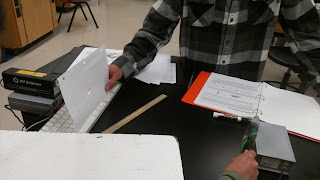The purpose of this activity is to understand how the time interval between the two events and the length of the objects in spaces depending on the inertial frame of reference. Based on the relativity, the clock of an object moving with the constant velocity runs slower compared with the rest one. This is demonstrated by the relationship between the time interval of the moving and stationary light clock:
∆t = γ∆t0,
where
∆t is the time interval of the moving light clock, γ is the Lorentz factor, and ∆t0
is the time interval of the stationary light clock.
Not only the time interval, but also the length differs depending in the inertial frame of reference. An object moving with constant velocity sees the length of the object to be contracted compared to the object in the rest frame. The relationship is shown by the equation:
l= l0/γ
Where l is the length in the moving frame, and l0 is the length in the rest frame
Questions and images:
Part 1: relativity of time
Question 1: The distance traveled by the light pulse on the moving light clock is longer than the distance traveled by the pulse on the stationary light clock
Question 2: The time interval for the light pulse to travel on the moving light clock is longer compare to on the stationary light clock.
Question 3: If the time is measured in the moving moving light clock, it takes the same amount of time interval to complete a round trip.
Question 4: When the velocity of the light clock is decreased, the difference in the light pulse travel time between the earth's timer and the light clock's timer will be decreased.
Question 5: when the light clock
has a Lorentz factor (γ) of 1.2, it will take Δt = 8.00 µs for the light pulse to travel back and forth as measured on the earth.
Question 6: Calculate the Lorentz factor (γ) if Δt = 7.45 µs. Lorentz factor (γ) = 1.116
Part 2: Relativity of length
Question 1: As a pulse of light travels back and forth the light clock, the time interval of this round-trip does not depend on whether the light clock is moving or stationary relative to the earth.
Question 2: The round-trip time interval for the light pulse as measured on earth is longer than the time interval measured on the light clock.
Question 3: Yes, the length of the moving light clock is contracted by the Lorentz factor (γ) in order to obey the time-dilation relation.
Question 4: The light clock is 1000m long when measured at rest, it would be 769 m when the light clock had the Lorentz factor of 1.3.
Summary:The first part explains the concept of relativity of time. As shown in the pictures, the distance of the light pulse traveled on the moving light clock is lager the stationary light clock. Because the moving light clock moving with constant velocity, the light pulse leaved the light clock and returned at the different position in space. The path of the light pulse traveled is the hypotenuses in the moving light clock. Because its path is hypotenuses, it takes longer time for the moving light clock to complete a round-trip than the stationary light clock. If the observer is moving with the moving light clock, the time interval for a round-trip of the light pulse does not change, because the observer is moving the same speed with the light clock. In that case, the light clock is always stationary in the observer's frame of reference.
The second part explains the concept of length contraction in space. If the observer is riding on the left end of the light clock, the time interval for the light pulse travels a round-trip is the same whether the light clock is moving or stationary relative to the earth. This is because the observer is moving with the light clock, in the observer's frame, the light clock is stationary. However, if the light clocked is measured on the earth, the light clock is moving with the a constant velocity relative to the earth frame. The light pulse travels a longer distance than the object. Thus, it takes longer time interval for the light pulse travel back to the left end. As shown in the pictures, the length of the object is smaller in the moving light clock than in the stationary light clock. If the length is the same, the time interval as measured on the earth is not equal to γ∆t0
. This is because the light clock is moving with a certain speed, so the time
interval will become even greater since it has to travel a greater distance. The length of the moving object is equal to l0/γ

















